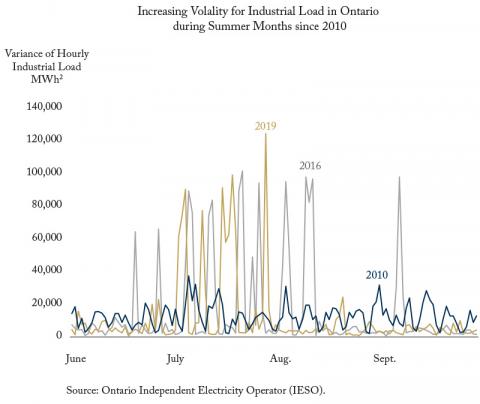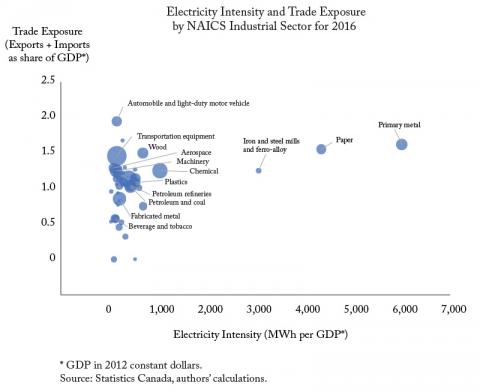From: Grant Bishop and Benjamin Dachis
To: Greg Rickford, Ontario Minister of Energy, Northern Development and Mines
Date: May 5, 2020
Re: Ontario industrial power prices are set to spike: A four-part reform
Ontario electricity rates for many businesses will surge just as power demand plunges. This perverse result occurs because reduced load must fund fixed costs for expensive contracts with generators at guaranteed prices. As discussed in an earlier Intelligence Memo, the spike in the Global Adjustment (into which those fixed costs are bundled) risks a death spiral for industrial power usage in Ontario.
Industrial electricity prices in Ontario were a growing problem pre-COVID-19. The government launched consultations in April of 2019. Yet, little progress has yet been announced.
The COVID-19-crisis has now exposed the unhappy effects of Ontario’s current market structure. Reforming Ontario electricity rates is the Kobayashi Maru – for non-Star Trek fans, a no-win scenario – of policy problems.
The best path forward is a gradual but decisive transition to more efficient, transparent, and predictable industrial pricing that promotes long-term off-peak growth in electricity use while protecting trade-exposed sectors.
In the immediate term, Ontario’s government has helped defray what would have been a 24 percent rise in power costs for industrial users, but only through June. Following this, more comprehensive reform should involve:
- Transferring this policy-driven cost of paying for renewable power to taxpayers from electricity ratepayers;
- Introducing an “interruptible rate” and phase-out of the distortionary Industrial Conservation Initiative (ICI or “High-5” program), which contributes to volatility and destroys power demand as industrial facilities chase the same peaks;
- Transitioning to a time-varying rate for the Global Adjustment – for example, with higher Global Adjustment rates at times when power demand is closer to system capacity; and
- Introducing express modifiers to reduce power rates for industrial sectors with load that is highly responsive (i.e., highly elastic) to power prices.
First, excessive prices for renewable contracts represent a policy error by an earlier government. The cost of wind, solar and biomass contracts were $3.7 billion in 2019 – representing 28 percent of the total Global Adjustment while only comprising 8 percent of generation. The government should reorient its now $5.6 billion electricity rate subsidy to curb renewable costs for all customers. The current subsidy program is mainly focused on lowering residential power bills. This ignores the impacts of elevated rates on businesses and discourages the siting of electricity-intensive operations in Ontario.
By extracting renewable costs from the Global Adjustment, taxpayers – rather than ratepayers – would transparently fund the costs of previous policy mistakes. The government should also consider means-testing for residential consumers the remaining support it would apply to households.
Second, the ICI should be phased-out. The program distorts power demand by imposing an arbitrarily high marginal cost for consuming power during certain hours. Because the ICI allows an industrial facility to avoid the Global Adjustment based on its share of power during the five hours with the greatest demand during a given year, consuming power during those peak hours represented a cost of approximately $110,000/MWh in 2019. With such excessive costs around peaks, the ICI contributes to increased volatility for directly-connected industrial loads as certain consumers chase the same peaks (see Figure 1). The Independent Electricity System Operator (IESO) should instead create a demand response auction into which ICI customers would make offers for the price to curtail their power consumption when the system is at capacity. This would create a market-based “interruptible rate” for ICI-eligible customers. ICI-eligible customers could get a lower fixed rate based on the amount of their demand they offer into the demand response market.
Third, the Global Adjustment does not vary by hour. Therefore, many industrial and commercial consumers lack incentive to smooth their power consumption. The ICI induces volatility around peak hours but does not encourage overall flattening of daily load. Smoothing load saves costs for a system by reducing the need for additional capacity to meet peak demand. Ontario should move to a time-varying Global Adjustment allocation. For example, the Global Adjustment rate could vary in proportion to the system’s reserve margin in a particular hour. This would encourage price-sensitive manufacturers to push production to early mornings to avoid high-use afternoons and evenings. The Ontario Energy Board is examining such a system and should introduce immediately a pilot pricing program for willing customers.
Finally, Ontario should modify rates for highly trade-exposed, electricity-intensive sectors (e.g., pulp and paper and steel manufacturing). Electricity use by these industries is highly responsive to changes in prices. If an industry is highly trade-exposed and/or electricity is a major cost component (see Figure 2), production is prone to “leakage” to other jurisdictions with lower power prices. Offering lower rates to those most able to move production elsewhere, and who would not benefit from a reformed ICI, is both economically efficient and politically palatable.
With Ontario industrial electricity prices set to skyrocket just as demand plummets, now is the time to push overdue reforms.
Grant Bishop is associate director, research, and Benjamin Dachis is director of public affairs at the C.D. Howe Institute.
To send a comment or leave feedback, email us at blog@cdhowe.org.
The views expressed here are those of the authors. The C.D. Howe Institute does not take corporate positions on policy matters.
Figure 1
Figure 2







